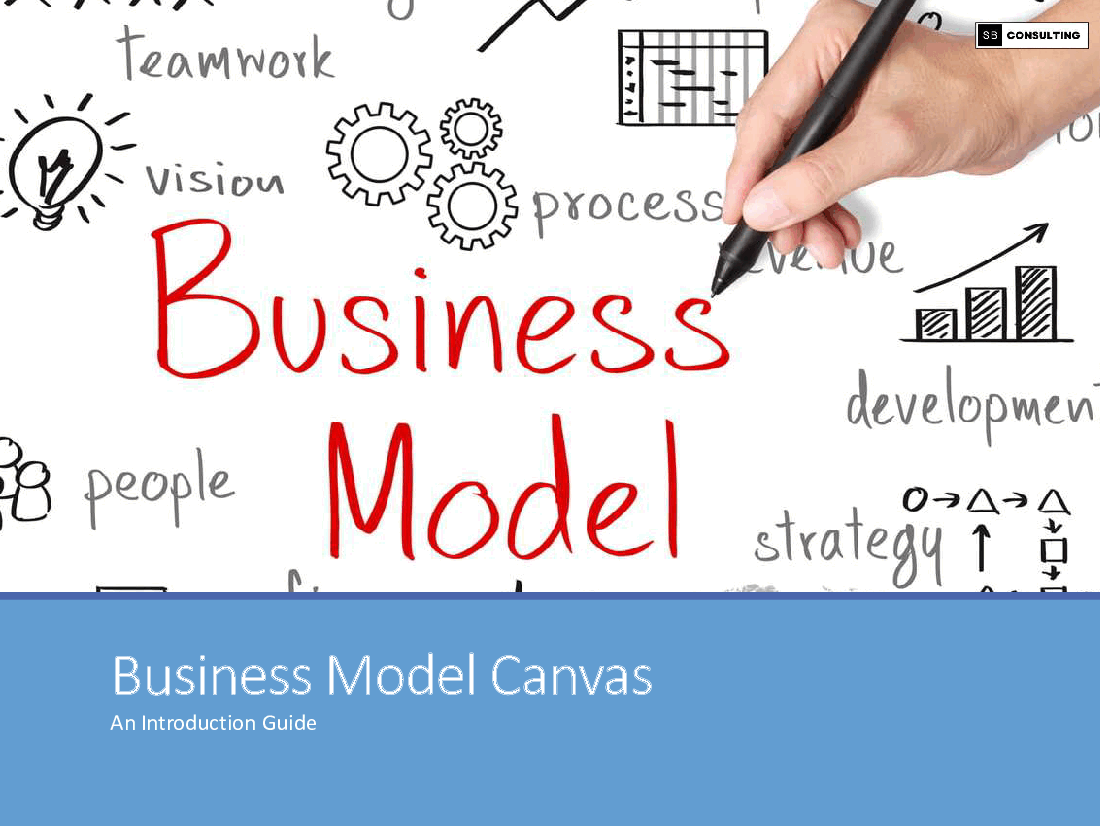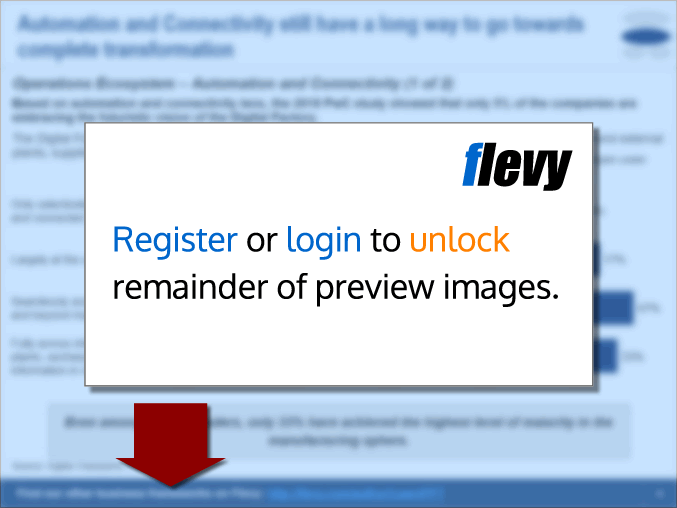Business Model Canvas (PowerPoint PPTX Slide Deck)
PowerPoint (PPTX) 131 Slides
BENEFITS OF DOCUMENT
- Provides a framework for understanding, analyzing and renovating your current business model or crafting a new one.
- Provides a tool which can be used in a collaborative setting such as a strategic planning workshop.
- Provides an overview of the business model canvas
DESCRIPTION
The Business Model Canvas is an essential tool for Strategic Management and Lean Startup methodologies, empowering businesses to develop new or enhance existing business models in order to gain a competitive advantage.
Originally developed by Strategyzer, this canvas takes the form of a visual chart comprising nine crucial building blocks. These components comprehensively address various aspects of an organization, including its core offering, infrastructure, customers, and finances. The nine building blocks consist of Customer Segments, Value Propositions, Channels, Customer Relationships, Revenue Streams, Key Resources, Key Activities, Key Partnerships, and Cost Structure.
This innovative tool has gained significant popularity and is frequently employed in collaborative settings, such as strategic planning workshops. By utilizing the Business Model Canvas, organizations are able to effectively align their activities, highlighting and exploring potential trade-offs in a structured manner. The canvas facilitates a hands-on approach, fostering comprehension, discussion, creativity, and analysis among participants. To further enhance understanding, the canvas is accompanied by a variety of illustrative business model examples, including prominent companies like Apple, Facebook, Skype, Amazon, Google, Starbucks, Nespresso, Xiaomi, Uber, Grab, as well as various industries such as low-cost airlines, creative digital advertising, and banks, including private banking.
The purpose of this presentation is to provide a foundational overview of the Business Model Canvas, offering users a fundamental understanding of this approach to business modeling. It is particularly suited for half-day or one-day workshops, serving as a valuable resource to familiarize participants with the Business Model Canvas, as well as other associated concepts and tools like Design Thinking and the Value Proposition Canvas. By engaging with these methodologies, organizations can enhance their strategic thinking and drive innovation within their business models.
////////////////////////////////////////////
Learning Objectives:
Understanding the Concept: The toolkit should provide a clear and comprehensive explanation of the Business Model Canvas, its purpose, and its significance in strategic management and business modeling. Learners should grasp the fundamental concepts and principles underlying the canvas.
Familiarity with Building Blocks: The toolkit should enable learners to become familiar with each of the nine building blocks of the Business Model Canvas, including Customer Segments, Value Propositions, Channels, Customer Relationships, Revenue Streams, Key Resources, Key Activities, Key Partnerships, and Cost Structure. Learners should understand the role and importance of each block in shaping a business model.
Practical Application: The toolkit should provide practical guidance on how to apply the Business Model Canvas in real-world scenarios. It should offer step-by-step instructions and examples to help learners effectively analyze, design, and iterate business models using the canvas.
Strategic Thinking: Learners should develop strategic thinking skills through the toolkit. They should learn how to identify and evaluate key elements of a business model, assess potential trade-offs, and explore innovative solutions to create competitive advantage.
Collaborative Problem-Solving: The toolkit should emphasize the collaborative nature of using the Business Model Canvas. It should encourage learners to engage in discussions, group activities, and workshops to effectively leverage the canvas as a team. Learners should understand how to foster creativity, encourage diverse perspectives, and collectively analyze and refine business models.
Integration with Other Tools: The toolkit may introduce learners to other related tools and methodologies, such as Design Thinking and the Value Proposition Canvas. Learners should understand how these tools complement the Business Model Canvas and can be used in conjunction to enhance strategic decision-making and innovation.
Case Studies and Examples: The toolkit should include relevant case studies and examples of successful business models to inspire learners and provide practical illustrations of the canvas in action. Learners should gain insights into how different organizations have effectively utilized the canvas to create value and achieve competitive advantage.
By addressing these learning objectives, a toolkit explaining the Business Model Canvas can equip learners with the necessary knowledge, skills, and mindset to effectively analyze, design, and adapt business models to meet the evolving demands of the market.
////////////////////////////////////////////
Content:
• Business Model Definition
• Elements of a Business Model
• The Importance of Business Models
• Business Model Components
• Nine Building Blocks
• Business Model Canvas PPTX Template
• Case Studies
• Different Views of the building blocks
• Checklists
////////////////////////////////////////////
Key Words:
Strategy & Transformation, Growth Strategy, Strategic Planning, Strategy Frameworks, Innovation Management, Pricing Strategy, Core Competencies, Strategy Development, Business Transformation, Marketing Plan Development, Product Strategy, Breakout Strategy, Competitive Advantage, Mission, Vision, Values, Strategy Deployment & Execution, Innovation, Vision Statement, Core Competencies Analysis, Corporate Strategy, Product Launch Strategy, BMI, Blue Ocean Strategy, Breakthrough Strategy, Business Model Innovation, Business Strategy Example, Corporate Transformation, Critical Success Factors, Customer Segmentation, Customer Value Proposition, Distinctive Capabilities, Enterprise Performance Management, KPI, Key Performance Indicators, Market Analysis, Market Entry Example, Market Entry Plan, Market Intelligence, Market Research, Market Segmentation, Market Sizing, Marketing, Michael Porter's Value Chain, Organizational Transformation, Performance Management, Performance Measurement, Platform Strategy, Product Go-to-Market Strategy, Reorganization, Restructuring, SWOT, SWOT Analysis, Service 4.0, Service Strategy, Service Transformation, Strategic Analysis, Strategic Plan Example, Strategy Deployment, Strategy Execution, Strategy Frameworks Compilation, Strategy Methodologies, Strategy Report Example, Value Chain, Value Chain Analysis, Value Innovation, Value Proposition, Vision Statement, Corporate Strategy, Business Development
NOTE:Our digital products are sold on an "as is" basis, making returns and refunds unavailable post-download. Please preview and inquire before purchasing. Please contact us before purchasing if you have any questions! This policy aligns with the standard Flevy Terms of Usage.
Got a question about the product? Email us at support@flevy.com or ask the author directly by using the "Ask the Author a Question" form. If you cannot view the preview above this document description, go here to view the large preview instead.
Source: Best Practices in Business Model Canvas PowerPoint Slides: Business Model Canvas PowerPoint (PPTX) Presentation Slide Deck, SB Consulting
This document is available as part of the following discounted bundle(s):
Save %!
The CEO Toolkit
This bundle contains 15 total documents. See all the documents to the right.
Save %!
Full Master of Business Administration (MBA) Course Material
This bundle contains 21 total documents. See all the documents to the right.
Save %!
The Entrepreneurship Toolkit
This bundle contains 17 total documents. See all the documents to the right.









